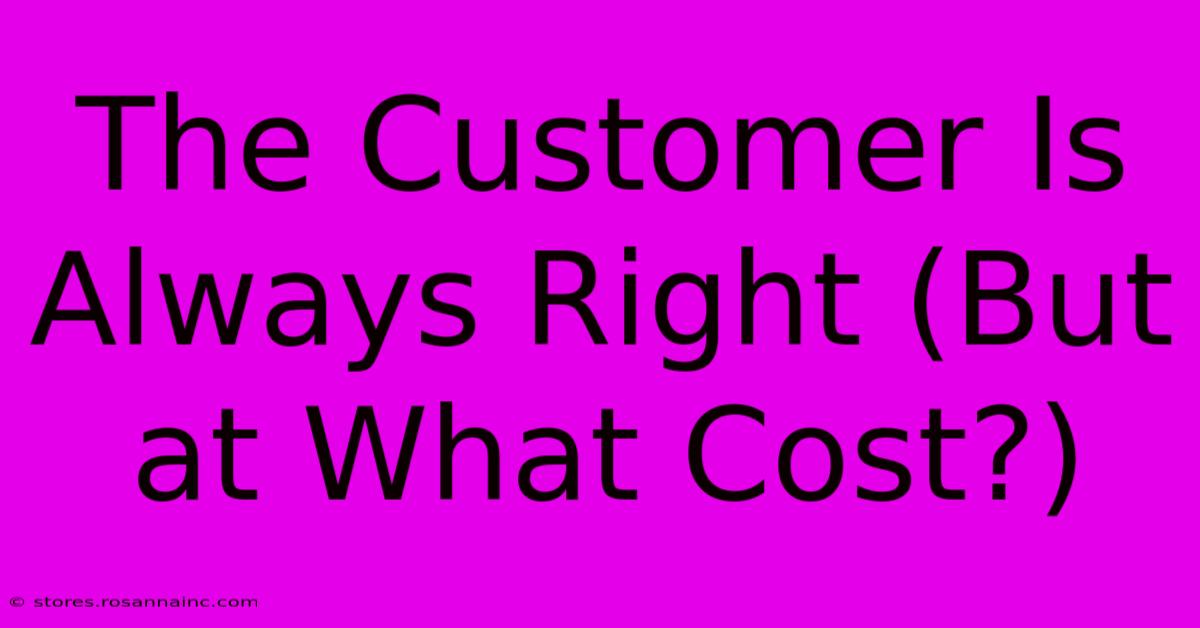The Customer Is Always Right (But At What Cost?)

Table of Contents
The Customer Is Always Right (But at What Cost?)
The adage "the customer is always right" has been a cornerstone of business philosophy for decades. But in today's increasingly complex and competitive market, this mantra needs a critical re-evaluation. While customer satisfaction is paramount, blindly adhering to this principle can be detrimental to a business's health and sustainability. Let's explore the nuances of this age-old saying and examine the potential costs associated with prioritizing customer satisfaction above all else.
The Upside of Customer-Centricity
Before diving into the potential downsides, it's crucial to acknowledge the significant benefits of a customer-centric approach. A strong focus on customer satisfaction leads to:
- Increased Loyalty: Happy customers are more likely to return and become repeat buyers, forming a valuable base of loyal clientele.
- Positive Word-of-Mouth Marketing: Satisfied customers often recommend your business to their friends and family, generating organic and cost-effective marketing.
- Stronger Brand Reputation: A reputation for excellent customer service can significantly enhance your brand image and attract new customers.
- Valuable Feedback: Engaging with customers allows businesses to gather valuable feedback, identify areas for improvement, and innovate.
When "The Customer Is Always Right" Goes Wrong
While the benefits are undeniable, there are instances where the unwavering belief that "the customer is always right" can be counterproductive:
1. The Cost of Unreasonable Demands
Some customers, unfortunately, make unreasonable or even abusive demands. Catering to these demands without setting boundaries can:
- Demoralize Staff: Constantly dealing with unreasonable customers can lead to burnout and decreased employee morale.
- Financial Losses: Providing free replacements, refunds, or significant discounts for every complaint, regardless of validity, can severely impact your profit margins.
- Negative Impact on Other Customers: Prioritizing unreasonable demands can lead to longer wait times and decreased service quality for other customers.
2. Enabling Abusive Behavior
Blindly accepting every customer complaint, even if unfounded, can inadvertently encourage abusive behavior. This can:
- Create a Culture of Entitlement: Customers may feel empowered to demand excessive concessions or act disrespectfully towards staff.
- Damage Employee Well-being: Employees subjected to constant abuse can experience stress, anxiety, and even trauma.
- Tarnish Brand Image: News of abusive customer behavior being tolerated can damage your brand's reputation.
3. Stifling Innovation & Efficiency
Overly prioritizing customer preferences without careful consideration can hinder innovation and operational efficiency. For example:
- Ignoring Valuable Data: Ignoring data-driven insights in favor of individual customer preferences can lead to inefficient resource allocation.
- Resisting Necessary Changes: Reluctance to implement necessary changes due to potential customer backlash can stifle growth and prevent the business from adapting to market trends.
Finding the Balance: Customer-Centricity with Boundaries
The key lies in finding a balance between prioritizing customer satisfaction and setting healthy boundaries. This involves:
- Empathetic but Firm Communication: Address customer concerns with empathy and professionalism, while firmly but politely upholding your policies.
- Clear Communication of Policies: Ensure your policies are clearly communicated to customers upfront, minimizing misunderstandings and disputes.
- Empowering Employees: Equip your staff with the tools and training to handle difficult customer interactions effectively and confidently.
- Collecting and Analyzing Feedback: Actively seek customer feedback, but analyze it objectively and use data-driven insights to inform business decisions.
- Implementing Customer Service Training: Invest in training for your staff to equip them with the skills to navigate challenging customer interactions professionally.
Conclusion: The Customer Matters, But So Does Your Business
The phrase "the customer is always right" should be reinterpreted as "the customer's needs are always important." Prioritizing customer satisfaction is crucial for business success. However, this should be done strategically, with clear boundaries and a focus on both customer needs and the long-term health of your business. By striking the right balance, you can create a thriving business that both delights customers and ensures sustainable growth.

Thank you for visiting our website wich cover about The Customer Is Always Right (But At What Cost?). We hope the information provided has been useful to you. Feel free to contact us if you have any questions or need further assistance. See you next time and dont miss to bookmark.
Featured Posts
-
Middlesex College Nj Whos Investing In Your Future
Feb 11, 2025
-
A To Z Of Color Elevate Your Home Decor
Feb 11, 2025
-
Worried About Jim Carrey Find Peace Of Mind Here
Feb 11, 2025
-
Unlocking The Secrets Of Area Code 479
Feb 11, 2025
-
Uncover The Untold Story Bonnie Erbe Wiki Secrets Revealed
Feb 11, 2025
